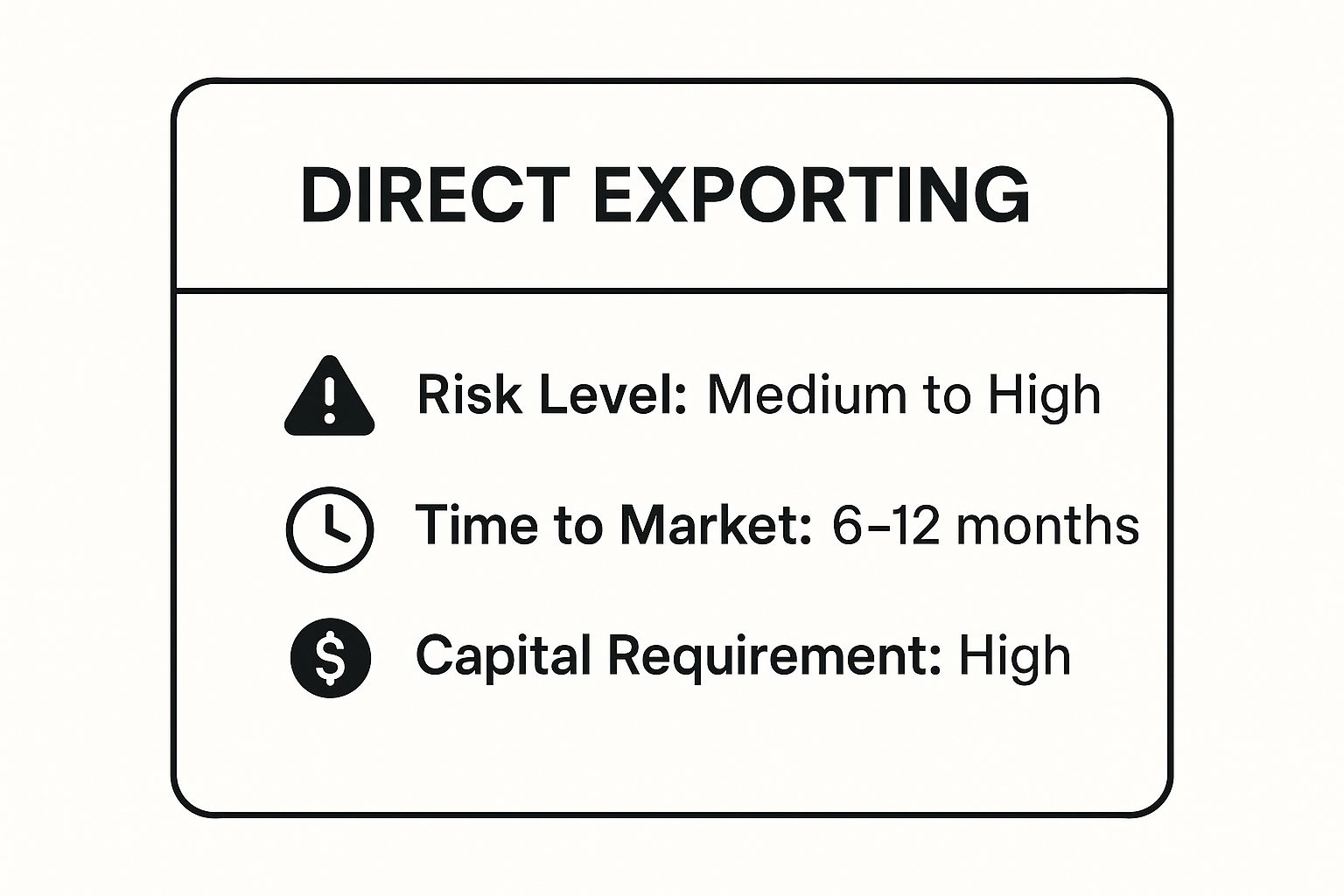Top Market Entry Strategies to Expand Globally
Unlocking Global Growth: Choosing the Right Path
Entering a new market requires a well-defined strategy. This listicle outlines seven key market entry strategies to help you expand your business internationally. We'll cover direct exporting, joint ventures, franchising, foreign direct investment (FDI), licensing, strategic alliances, and acquisitions. Understanding these options is crucial for minimizing risks and maximizing your potential for global success. Choosing the correct market entry strategy is the first step toward unlocking international growth.
1. Direct Exporting
Direct exporting is a market entry strategy where your company takes the reins and sells products directly to customers or distributors in foreign markets. This cuts out any intermediaries in your home country, giving you complete control over the export process, from the factory floor to the final sale. Unlike indirect exporting, where you leverage third-party agents or trading companies, direct exporting puts you in the driver's seat of your international expansion. This approach requires a greater investment of resources and carries more risk, but it also offers significantly higher potential rewards. It's a powerful way to build your brand globally and foster direct relationships with your international clientele.
Direct exporting involves managing all aspects of the export process internally. This includes market research, identifying potential customers or distributors, handling logistics, managing payments, and ensuring compliance with international regulations. This hands-on approach allows companies to build stronger brand recognition, tailor their marketing efforts to specific markets, and respond quickly to changing market demands.
Several well-known companies have successfully implemented direct exporting strategies. Tesla, for example, directly exports its electric vehicles to European and Asian markets. Apple sells its iPhones directly through its international Apple Stores, maintaining tight control over its brand image and customer experience. Boeing, a major player in the aerospace industry, sells aircraft directly to international airlines. Finally, Caterpillar exports heavy machinery directly to construction companies worldwide, demonstrating the scalability of this strategy across different industries. These examples highlight the effectiveness of direct exporting for reaching global markets and establishing a strong international presence.
When considering entering a new international market, understanding the required investment, time commitment, and potential risks is critical. Direct exporting provides the greatest control and potential returns, but also demands substantial resources. The following infographic summarizes these key aspects to help you quickly assess the commitment involved.
As visualized above, direct exporting requires a high capital investment and typically takes 6-12 months to establish, while also carrying a medium to high risk level. This reinforces the importance of thorough planning and resource allocation before choosing this market entry strategy.
So, when is direct exporting the right choice for your business? It's a particularly effective strategy when:
- You want maximum control over your brand and operations. Direct exporting gives you the ability to shape your brand narrative and customer experience in the target market.
- You have products with high-profit margins that can absorb the increased costs associated with direct exporting. The higher profit margins associated with this method can justify the significant initial investment.
- You want to build direct relationships with your customers and gather firsthand market feedback. This is crucial for long-term growth and adapting your offerings to local preferences.
However, direct exporting is not without its challenges. Some of the key drawbacks include:
- High initial investment: Setting up the necessary infrastructure, logistics, and marketing efforts can be expensive.
- Significant resource commitment: Managing the entire export process requires dedicated personnel and expertise.
- Complex logistics and regulatory compliance: Navigating international shipping, customs regulations, and local laws can be complex and time-consuming.
- Higher risk exposure: Direct exporters are more exposed to market fluctuations and political instability.
To increase your chances of success with direct exporting, consider these actionable tips:
- Thorough Market Research and Regulatory Understanding: Begin by researching your target market thoroughly. Understand the local consumer behavior, competition, and regulatory environment.
- Local Language and Cultural Training: Invest in local language capabilities and cultural training for your team. This will facilitate communication and build rapport with foreign customers and partners.
- Robust Logistics and Supply Chain Networks: Establish efficient and reliable logistics and supply chain networks to ensure timely delivery of your products.
- Relationships with Local Banks and Financial Institutions: Building relationships with local banks and financial institutions will streamline financial transactions and provide access to local market expertise.
- Local Sales Representatives or Regional Offices: Consider hiring local sales representatives or establishing regional offices to enhance your on-the-ground presence and market penetration.
Direct exporting offers a pathway to significant growth and global brand recognition for companies willing to invest the necessary resources and navigate the complexities of international trade. While it presents challenges, the potential rewards in terms of control, profit margins, and customer relationships make it a compelling market entry strategy.
2. Joint Ventures
Joint ventures represent a powerful market entry strategy, offering businesses a collaborative pathway to expand into new territories and capitalize on shared resources and expertise. This approach involves forming a strategic alliance with one or more companies, typically from different countries, to combine strengths and mitigate the risks associated with international expansion. In essence, a joint venture creates a new entity, jointly owned and operated by the partnering companies, specifically designed to pursue the shared market entry objectives. This method deserves its place on the list of market entry strategies due to its potential for rapid growth, access to local knowledge, and shared risk mitigation, making it a particularly attractive option for companies seeking to enter complex or unfamiliar markets.
A joint venture functions by leveraging the complementary resources and capabilities of each partner. One partner might bring in-depth local market knowledge, distribution networks, and regulatory expertise, while the other contributes technological innovation, product development capabilities, or established brand recognition. This synergistic approach allows both parties to achieve more together than they could independently. A formal legal entity, often a new company, is usually created, outlining the ownership structure, operational responsibilities, and profit/loss sharing arrangements. This provides a framework for the venture to operate independently while adhering to the agreed-upon strategic objectives.
Several prominent examples illustrate the success of joint ventures as a market entry strategy. Sony Ericsson, a joint venture between Sony Corporation and Ericsson, effectively combined Sony's consumer electronics expertise with Ericsson's mobile telecommunications technology to successfully enter the highly competitive mobile phone market. Starbucks' partnership with the Tata Group provided the coffee giant with invaluable access to the burgeoning Indian market, leveraging Tata's deep understanding of local consumer preferences and distribution channels. In the automotive industry, Volkswagen's joint venture with SAIC Motor facilitated its entry into the Chinese market, while General Motors pursued a similar strategy, also partnering with SAIC Motor to navigate the complexities of the Chinese automotive landscape. These examples highlight how joint ventures can bridge geographical and cultural gaps, enabling companies to establish a strong presence in new markets.
When considering a joint venture as a market entry strategy, several factors warrant careful consideration. This approach is particularly suitable when:
- Market entry barriers are high: Regulatory restrictions, complex distribution networks, or strong local competition can make independent entry challenging.
- Local market knowledge is critical: Understanding consumer preferences, cultural nuances, and business practices is essential for success.
- Resource sharing is advantageous: Pooling financial resources, technological expertise, or manufacturing capabilities can significantly enhance competitiveness.
- Risk mitigation is a priority: Sharing the financial and operational risks with a partner can reduce the burden on individual companies.
While joint ventures offer numerous advantages, including access to local market knowledge and networks, shared financial risk, faster market entry, and potential regulatory advantages, they also present certain challenges. Potential conflicts can arise over strategy and operations, profits are shared, and control is diluted. There is also a risk of intellectual property theft and potential difficulties navigating cultural and management style differences. Furthermore, the venture's success becomes dependent on the partner's performance and commitment.
To maximize the chances of a successful joint venture, consider the following tips:
- Conduct thorough due diligence: Investigate potential partners carefully, assessing their financial stability, reputation, and strategic alignment.
- Establish clear governance structures: Define roles, responsibilities, and decision-making processes upfront to avoid future conflicts.
- Protect intellectual property: Implement robust mechanisms to safeguard sensitive information and technology.
- Plan for the future: Create detailed exit strategies and dissolution procedures to address potential contingencies.
- Foster strong relationships: Invest time in building trust and understanding cultural differences between partners.
Joint ventures, when implemented strategically and with careful planning, can provide a powerful avenue for companies seeking to expand their global reach and capitalize on the synergistic benefits of collaboration. They offer a balanced approach to market entry, allowing businesses to leverage local expertise while mitigating the inherent risks of international expansion. Companies like Sony Corporation, General Electric, Toyota Motor Corporation, and Unilever have popularized this strategy, demonstrating its effectiveness across diverse industries and markets.
3. Franchising
Franchising represents a compelling market entry strategy that allows businesses to expand their reach rapidly with significantly lower capital investment compared to establishing wholly-owned subsidiaries. It's a symbiotic business model where a franchisor grants a franchisee the right to operate a business using the franchisor's established brand, business model, and operational systems. In return, the franchisee pays fees and royalties to the franchisor. This arrangement allows the franchisor to leverage local expertise and resources while maintaining brand consistency across multiple locations, making it a powerful tool for international expansion.
At its core, franchising is about replicating a proven business model. The franchisor provides a comprehensive package that includes standardized operational procedures, brand licensing and trademark usage rights, and ongoing support and training. This standardized approach ensures consistency in product quality, customer service, and brand image across all franchise locations. The franchisee, in turn, benefits from the established brand recognition, proven business model, and ongoing support, minimizing the risks associated with starting a business from scratch. The royalty-based revenue model ensures a steady income stream for the franchisor while incentivizing the franchisee to maximize profitability.
Franchising deserves its place on the list of market entry strategies due to its unique blend of rapid expansion potential and reduced risk. It offers a compelling alternative to the significant capital outlay and operational complexities associated with establishing a direct presence in a new market. This strategy is particularly well-suited for businesses with a well-defined business model, strong brand recognition, and scalable operational systems.
Features of Franchising:
- Standardized business model and operational procedures: Ensures consistency and replicability across all franchise locations.
- Brand licensing and trademark usage rights: Provides franchisees with immediate brand recognition and marketing power.
- Ongoing support and training from franchisor: Equips franchisees with the knowledge and skills to operate the business effectively.
- Royalty-based revenue model: Creates a steady income stream for the franchisor and aligns incentives with the franchisee.
- Local ownership with global brand standards: Combines the advantages of local market knowledge with the strength of a global brand.
Pros of Franchising:
- Rapid market expansion with minimal capital investment: Allows for faster growth compared to other market entry strategies.
- Local franchisees provide market knowledge and cultural insights: Facilitates adaptation to local market conditions and consumer preferences.
- Reduced operational and financial risk: The franchisor shares the risk with the franchisee.
- Steady revenue stream through royalties: Provides a predictable income source for the franchisor.
- Local partners handle day-to-day operations: Frees up the franchisor to focus on strategic growth and brand development.
Cons of Franchising:
- Limited control over local operations and quality: Maintaining consistent quality across all franchise locations can be challenging.
- Dependence on franchisee performance for brand reputation: The actions of a single franchisee can impact the entire brand.
- Revenue sharing through royalty payments: The franchisor doesn't retain all of the profits generated by the franchisee.
- Potential conflicts with franchisees over standards: Disagreements over operational procedures or brand standards can arise.
- Risk of franchisee becoming competitor after learning business model: Franchise agreements need to address this potential risk effectively.
Examples of Successful Franchising:
- McDonald's: A globally recognized fast-food giant with a franchise network spanning over 100 countries.
- Subway: A leading sandwich chain that has achieved significant international expansion through franchising.
- KFC: A prominent fried chicken brand with a presence in over 140 countries via franchising.
- 7-Eleven: A ubiquitous convenience store chain operating under a franchise model worldwide.
Tips for Successful Franchising:
- Develop comprehensive franchise manuals and training programs: Provide detailed guidance on all aspects of business operations.
- Establish strict quality control and monitoring systems: Ensure consistent quality and adherence to brand standards.
- Select franchisees with relevant experience and financial capability: Choose partners who are well-equipped to succeed.
- Adapt products and services to local tastes while maintaining core standards: Balance global brand consistency with local market preferences.
- Provide ongoing support and regular performance reviews: Offer continuous assistance and monitor franchisee performance.
Franchising, when executed effectively, can be a highly successful market entry strategy. By carefully considering the pros and cons and implementing the tips provided, businesses can leverage the power of franchising to achieve rapid growth and global reach. Pioneered by figures like Ray Kroc (McDonald's), Dave Thomas (Wendy's), Harland Sanders (KFC), and Fred DeLuca (Subway), franchising has proven to be a viable and powerful business model for both established brands and aspiring entrepreneurs.
4. Foreign Direct Investment (FDI)
Foreign Direct Investment (FDI) represents one of the most comprehensive market entry strategies available to businesses seeking international expansion. It involves a substantial, long-term commitment to a foreign market through direct investment in physical assets, operations, or business interests within that country. This approach goes beyond simply exporting or licensing; it signifies a deep level of engagement and control within the target market, making it a powerful, albeit complex, method for achieving global growth. As a market entry strategy, FDI offers businesses significant control and potential for high returns, but also requires careful planning and consideration of the associated risks.
FDI can take various forms, each offering different levels of control and involvement. Establishing new manufacturing facilities, often referred to as "greenfield investments," allows companies to build operations tailored to their specific needs. Acquiring existing local companies provides immediate access to established market share, distribution networks, and brand recognition. Alternatively, forming joint ventures with local partners can offer valuable insights into the market and shared resources while mitigating some of the risks associated with solo entry. Choosing the right form of FDI depends heavily on the company's resources, risk tolerance, and strategic objectives within the target market.
Numerous successful examples demonstrate the power of FDI as a market entry strategy. Toyota’s manufacturing plants in the United States have allowed the company to produce vehicles closer to its target market, reduce transportation costs, and build a strong brand presence. Samsung's investment in semiconductor fabrication facilities in Texas similarly showcases FDI’s role in accessing strategic resources and establishing a foothold in key markets. Nestlé's food processing plants in emerging markets demonstrate a commitment to local production, catering to specific consumer preferences and building a robust supply chain. IKEA, with its global network of retail stores and distribution centers, exemplifies the use of FDI to create a consistent brand experience and efficient supply chain management across international borders. These examples highlight how FDI can be adapted and applied across diverse industries and geographies.
While FDI holds substantial promise, it's crucial to understand the associated benefits and drawbacks. On the plus side, FDI offers complete control over operations and strategic decisions, maximizing profit potential and revenue retention. A physical presence through facilities or subsidiaries builds a strong local market presence and credibility, fostering trust with consumers and partners. Direct investment also grants access to local resources and supply chains, potentially reducing costs and improving efficiency. Moreover, some countries offer tax advantages and government incentives to attract foreign investment, further enhancing the financial appeal of FDI.
However, the significant financial commitment required for FDI represents a substantial hurdle. Building facilities, acquiring companies, or launching new ventures requires significant capital investment and carries inherent financial risks. Political and economic instability in the target market can also pose challenges, impacting operations and profitability. Navigating complex regulatory and legal requirements can be time-consuming and costly. Furthermore, the payback period for FDI can be lengthy, demanding patience and strategic foresight. Finally, the risk of asset expropriation or nationalization, though rare, must be considered, particularly in politically volatile regions.
For businesses considering FDI, thorough planning and careful execution are essential. Conducting comprehensive political and economic risk assessments is paramount to understanding the potential challenges and opportunities within the target market. Familiarizing yourself with local labor laws and employment regulations is crucial for smooth operations and compliance. Building relationships with government officials and regulatory bodies can facilitate the navigation of bureaucratic processes. Starting with smaller investments before making major commitments allows companies to test the market and gain valuable experience before fully committing. Finally, developing clear exit strategies and risk mitigation plans is vital for navigating unforeseen circumstances and protecting the investment.
When choosing a market entry strategy, FDI should be considered when a company seeks maximum control over its operations, aims for long-term market penetration, and possesses the financial resources to make a substantial investment. It is most suitable for companies with clearly defined international expansion goals, a high risk tolerance, and a desire to build a strong, localized presence in the target market. While other market entry strategies, like exporting or licensing, may offer lower initial costs and less risk, FDI provides the greatest potential for market dominance, brand building, and long-term profitability.
5. Licensing: A Low-Risk Market Entry Strategy
Licensing presents a compelling market entry strategy, particularly for companies possessing valuable intellectual property (IP) like patents, trademarks, copyrights, designs, or trade secrets. It offers a relatively low-risk avenue for expanding into new markets without substantial capital outlay or operational complexity. Essentially, licensing involves a contractual agreement where the licensor grants the licensee the right to utilize its IP in a defined geographic area for a specific time period in exchange for compensation, typically in the form of royalties or fees. This approach allows companies to monetize existing assets and test international waters before committing to more resource-intensive market entry strategies.
This method distinguishes itself from other market entry strategies like direct investment or joint ventures because the licensor doesn’t assume the operational burdens of manufacturing, marketing, or distribution. These responsibilities fall on the licensee, who leverages their local expertise and existing infrastructure to bring the licensed product or service to market. This makes licensing a particularly attractive market entry strategy for smaller businesses or those lacking the resources for direct expansion. It allows them to reach new customers, diversify revenue streams, and enhance brand recognition without the significant financial and managerial commitment required for establishing a physical presence in a foreign market.
One of the most prominent examples of successful licensing is the Walt Disney Company. Disney licenses its iconic characters, movies, and other IP to a vast network of manufacturers worldwide, generating significant revenue from toys, apparel, video games, and countless other products. This strategy allows Disney to penetrate numerous markets efficiently while minimizing its own operational footprint. Microsoft’s licensing of its Windows operating system to computer manufacturers globally is another powerful illustration of licensing’s potential. This strategy cemented Windows’ dominance in the PC market, creating a mutually beneficial relationship for Microsoft and its hardware partners. Other successful examples include Coca-Cola licensing its bottling rights and Nike licensing its footwear technology. These diverse examples highlight the versatility of licensing as a market entry strategy across different industries.
While licensing offers numerous advantages, it's crucial to be aware of the potential drawbacks. One key concern is the limited control the licensor has over product quality, brand representation, and overall market execution. This reliance on the licensee can expose the brand to reputational risks if the licensee fails to maintain expected standards. There's also the risk of nurturing a potential future competitor, especially if the licensee gains valuable knowledge and experience through the licensing agreement. Furthermore, profit margins are generally lower compared to direct operations, as the licensee receives a share of the revenue generated. Finally, the possibility of intellectual property theft or misuse always exists, emphasizing the need for robust legal protection.
To mitigate these risks and maximize the benefits of licensing as a market entry strategy, businesses should consider the following actionable tips:
- Robust Legal Agreements: Prioritize comprehensive legal agreements that clearly define the scope of the license, IP protection measures, quality control standards, performance expectations, and termination clauses. This is crucial to protect the licensor's interests and minimize potential disputes.
- Due Diligence on Licensees: Thoroughly vet potential licensees, focusing on their reputation, financial stability, market experience, and manufacturing capabilities. Choosing a reliable and competent partner is vital for successful licensing arrangements.
- Establish Clear Quality Standards: Define and communicate clear quality standards and implement effective monitoring mechanisms to ensure that the licensee adheres to the required specifications and maintains brand integrity. Regular audits and inspections are crucial in this regard.
- Performance Monitoring and Termination Clauses: Implement clear performance metrics and include termination clauses in the agreement to address potential performance failures or breaches of contract. This provides the licensor with recourse if the licensee does not meet agreed-upon obligations.
Licensing is a valuable tool within the broader spectrum of market entry strategies. It allows companies, particularly those with strong intellectual property, to expand their global reach, generate revenue from existing assets, and test new markets with minimal financial risk. By carefully considering the pros and cons, implementing robust legal safeguards, and selecting reliable partners, businesses can leverage the power of licensing to achieve their international growth objectives. While not suitable for every scenario, licensing deserves a place in the arsenal of any company exploring international expansion, offering a unique balance of opportunity and risk mitigation.
6. Strategic Alliances: Leveraging Partnerships for Market Entry
Strategic alliances represent a powerful market entry strategy where companies pool resources and expertise to achieve shared objectives. This collaborative approach allows businesses to expand into new markets, access valuable resources, and mitigate risks without the complexities and commitment of a merger or acquisition. Instead of creating a new legal entity, partners maintain their independence while working together towards specific, mutually beneficial goals. This makes strategic alliances a particularly attractive option for companies seeking a flexible and less resource-intensive method of market entry. This strategy deserves its place on this list due to its effectiveness in facilitating rapid expansion, minimizing financial burden, and providing access to established networks and expertise.
A strategic alliance is essentially a formalized partnership between two or more companies. This partnership can take various forms, including marketing alliances, technology partnerships, distribution agreements, joint ventures (though these typically involve a separate legal entity for the specific venture), and research and development collaborations. The key element is a shared understanding of the objectives and a commitment to contributing resources towards their achievement. This can involve sharing distribution networks, customer databases, technology, intellectual property, or marketing expertise.
How Strategic Alliances Work:
The process typically begins with identifying a suitable partner whose strengths complement your own and whose market presence aligns with your target market. Once a potential partner is identified, the next step involves negotiating the terms of the alliance. This includes defining the specific objectives, outlining each partner's roles and responsibilities, determining the duration of the alliance, and establishing mechanisms for decision-making, communication, and conflict resolution. A well-defined agreement is crucial for the success of the alliance, ensuring that all parties are aligned and expectations are clearly managed. The alliance then enters the implementation phase, where partners actively collaborate to achieve the agreed-upon objectives. Regular monitoring and evaluation are essential to ensure the alliance is on track and to make necessary adjustments.
Examples of Successful Strategic Alliances:
Several successful strategic alliances demonstrate the effectiveness of this market entry strategy:
-
Spotify and Uber: This partnership allowed Uber riders to control the music during their rides through their Spotify accounts, enhancing the user experience and expanding Spotify's reach. This benefited both companies, leveraging Uber's existing customer base and providing Spotify with a new platform for user engagement.
-
Starbucks and Barnes & Noble: Starbucks gained access to Barnes & Noble’s customer base by opening in-store coffee shops, while Barnes & Noble enhanced its in-store experience. This provided a complementary service for Barnes & Noble customers and a new distribution channel for Starbucks.
-
Microsoft and Samsung: This alliance involved pre-installing Microsoft software on Samsung Android devices, benefiting both companies. Microsoft expanded its software reach within the Android ecosystem, and Samsung enhanced the value proposition of its devices.
-
Amazon and Whole Foods: This alliance enabled Amazon to expand into the grocery market by leveraging Whole Foods’ established infrastructure and brand recognition. It provided Amazon with a brick-and-mortar presence in the grocery sector and gave Whole Foods access to Amazon's vast logistical network and online platform.
When and Why to Use Strategic Alliances:
Strategic alliances are particularly beneficial in the following situations:
- Entering new markets: Leveraging a local partner's existing distribution network and market knowledge can significantly accelerate market entry and reduce associated risks.
- Accessing specific resources or capabilities: Partnering with a company possessing complementary resources or technologies can fill gaps in your own capabilities and enhance your competitive advantage.
- Sharing costs and risks: Joint ventures distribute the financial burden and risks associated with market entry, making it a less daunting proposition for smaller businesses or those entering particularly challenging markets.
- Overcoming trade barriers: In some cases, partnering with a local company is essential to navigate complex regulatory landscapes and overcome trade barriers.
Pros and Cons of Strategic Alliances:
Pros:
- Access to partner's distribution networks and customer base
- Shared costs and reduced financial risk
- Flexibility to modify or terminate arrangements
- Learning opportunities and knowledge transfer
- Faster market entry through established relationships
Cons:
- Potential conflicts over goals and strategies
- Risk of partner becoming competitor
- Dependency on partner's performance and commitment
- Intellectual property and confidentiality concerns
- Complex coordination and management requirements
Tips for Successful Strategic Alliances:
- Clearly define roles, responsibilities, and expectations: A well-defined agreement is crucial for avoiding misunderstandings and conflicts.
- Establish governance structures for decision-making: Clear decision-making processes ensure efficient and effective collaboration.
- Create performance metrics and review mechanisms: Regular monitoring and evaluation are essential to track progress and make adjustments as needed.
- Develop contingency plans for partnership dissolution: A pre-agreed exit strategy minimizes disruption in the event the alliance needs to be terminated.
- Maintain open communication channels between partners: Open and honest communication is essential for building trust and resolving issues proactively.
By carefully considering the potential benefits and challenges and following the tips outlined above, businesses can leverage the power of strategic alliances to achieve successful market entry and sustainable growth.
7. Acquisition
Acquisition, as a market entry strategy, involves purchasing an existing business operating within your target market. This approach offers a rapid path to establishing a presence, acquiring a ready-made customer base, and gaining immediate access to operational infrastructure. While it presents a powerful shortcut to market penetration, acquisition demands significant capital investment and careful integration expertise to ensure a successful transition. It's a high-stakes game with the potential for substantial rewards, but also significant risks if not executed meticulously.
This market entry strategy revolves around acquiring either the assets of a company or assuming ownership of the entire entity. This provides instant access to market share, operational capabilities, established distribution networks, and invaluable local expertise. The acquirer effectively inherits the target company's resources, including its brand recognition, customer relationships, and supply chains. This significantly reduces the time and effort required to build these elements from scratch, making acquisition an attractive option for companies seeking rapid market entry.
Several high-profile examples demonstrate the power of acquisition as a market entry strategy. Walmart's acquisition of Flipkart provided the retail giant with immediate access to the burgeoning Indian e-commerce market. Similarly, Uber's acquisition of Careem solidified its presence in the Middle East, while Facebook's acquisition of WhatsApp bolstered its global messaging market dominance. Disney's acquisition of 21st Century Fox serves as another prime example, allowing Disney to expand its content library and extend its international reach. These examples underscore how acquisitions can be instrumental in quickly gaining a foothold in new markets and achieving strategic growth objectives.
When and Why to Use Acquisition as a Market Entry Strategy:
Acquisition becomes a compelling market entry strategy under specific circumstances:
- Speed to Market is Crucial: When time is of the essence and a company needs to establish a presence quickly, acquisition provides the fastest route.
- High Barriers to Entry: In markets with significant regulatory hurdles, strong incumbent competition, or complex logistical challenges, acquiring an existing player can bypass these obstacles.
- Synergies and Growth Potential: If the target company offers complementary products, technologies, or customer bases, an acquisition can create valuable synergies and fuel accelerated growth.
- Access to Local Expertise: Acquiring a local company provides immediate access to market knowledge, established relationships, and a culturally integrated workforce.
Pros of Acquisition:
- Immediate market entry: Start operations from day one with established infrastructure.
- Existing customer base: Gain access to a loyal customer base and established distribution channels.
- Local market knowledge: Benefit from the acquired company's understanding of local regulations, culture, and consumer preferences.
- Elimination of a competitor: Reduce competitive pressure by absorbing a rival.
- Faster revenue generation: Compared to greenfield investments, acquisitions can generate revenue much faster.
Cons of Acquisition:
- High capital investment: Acquisitions often require substantial upfront costs.
- Integration challenges: Merging two companies can be complex, involving cultural differences, conflicting systems, and potential redundancies.
- Hidden liabilities: Unforeseen financial or legal issues may surface after the acquisition is complete.
- Loss of key talent: Employees of the acquired company may choose to leave, taking valuable expertise with them.
- Regulatory scrutiny: Large acquisitions may require regulatory approvals and face antitrust concerns.
Tips for Successful Acquisitions:
- Thorough Due Diligence: Conduct a comprehensive assessment of the target company's financials, operations, and legal standing.
- Integration Planning: Develop a detailed integration plan before closing the deal, addressing key aspects such as organizational structure, systems integration, and cultural alignment.
- Talent Retention: Implement incentive programs to retain key employees and ensure a smooth transition.
- Stakeholder Communication: Communicate clearly and consistently with customers, employees, and other stakeholders throughout the acquisition process.
- Change Management: Develop a robust change management strategy to address the inevitable disruptions and uncertainties that arise during integration.
Acquisition, while a potentially lucrative market entry strategy, is not without its challenges. Careful planning, thorough due diligence, and effective integration are essential for maximizing the chances of success. By following these tips and learning from the experiences of successful acquirers like Warren Buffett, Jack Welch, Carlos Ghosn, and Bob Iger, businesses can leverage acquisitions to achieve their strategic goals and establish a strong presence in new markets.
Market Entry Strategies Comparison
| Strategy | Implementation Complexity 🔄 | Resource Requirements ⚡ | Expected Outcomes 📊 | Ideal Use Cases 💡 | Key Advantages ⭐ |
|---|---|---|---|---|---|
| Direct Exporting | High 🔄🔄🔄 | High ⚡⚡⚡ | High profit margins, full control 📊📊 | Companies with export infrastructure | Maximum control, faster market response ⭐⭐ |
| Joint Ventures | Medium 🔄🔄 | Medium to High ⚡⚡ | Shared risks and profits, faster entry 📊 | Markets needing local knowledge or regulation navigation | Access to local expertise, shared risk ⭐⭐ |
| Franchising | Low to Medium 🔄 | Low to Medium ⚡ | Rapid expansion, steady royalties 📊 | Businesses with scalable models, brand focus | Rapid growth, low capital requirement ⭐ |
| Foreign Direct Investment (FDI) | Very High 🔄🔄🔄🔄 | Very High ⚡⚡⚡⚡ | Strong local presence, max control 📊📊📊 | Long-term commitment markets, large-scale manufacturing | Complete control, tax incentives ⭐⭐⭐ |
| Licensing | Low 🔄 | Very Low ⚡ | Quick entry, low risk, royalties 📊 | Monetizing IP with minimal investment | Low financial risk, fast market access ⭐ |
| Strategic Alliances | Low to Medium 🔄 | Low to Medium ⚡ | Shared resources, flexible partnerships 📊 | Niche market access, technology sharing | Flexibility, cost-sharing, speed ⭐⭐ |
| Acquisition | Very High 🔄🔄🔄🔄 | Very High ⚡⚡⚡⚡ | Immediate presence, high profit potential 📊📊 | Fast market access, competitor elimination | Instant market access, existing assets ⭐⭐⭐ |
Navigating Your Global Expansion Journey
Choosing the right market entry strategy is paramount to successfully expanding your business internationally. We've explored several key market entry strategies, from direct exporting and joint ventures to franchising, foreign direct investment (FDI), licensing, strategic alliances, and acquisitions. Each offers distinct advantages and disadvantages, impacting your level of control, required investment, and potential return. The most effective strategy depends on your specific business goals, available resources, risk tolerance, and the target market itself. Mastering these concepts is not just about understanding the theoretical frameworks; it's about equipping yourself with the tools to make informed decisions that drive tangible growth and unlock new revenue streams.
Expanding globally requires careful planning and execution. For businesses venturing into international markets, understanding the nuances of cross-border e-commerce is crucial. This resource from ECORN, "Cross Border E-commerce: Your Proven Playbook for Global Market Success," offers valuable insights into navigating the complexities of international online sales.
Your next step should be to thoroughly analyze your business and target markets, weighing the pros and cons of each market entry strategy. Remember, successful international expansion requires more than just choosing the right entry point; it demands a deep understanding of market dynamics, including cultural nuances and regulatory landscapes. A well-defined market entry strategy, combined with robust trading insights, can significantly increase your chances of success. Ready to enhance your trading skills and navigate the global markets with confidence? Colibri Trader provides the tools and education you need to effectively analyze markets, identify opportunities, and execute your chosen market entry strategy with precision. Explore Colibri Trader today and discover how to maximize your potential in the global marketplace.








